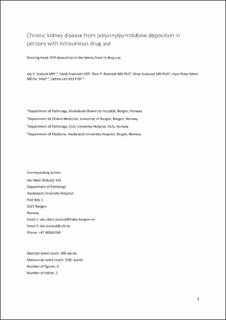| dc.description.abstract | Background and objectives: Persons with intravenous drug use have a higher risk of developing CKD compared with the general population. In Norway, deposits of polyvinylpyrrolidone have been observed in kidney biopsies taken from persons with opioid addiction and intravenous drug use since 2009. Polyvinylpyrrolidone is an excipient commonly used in pharmaceuticals, and the polyvinylpyrrolidone deposits observed in these patients were caused by intravenous injection of a specific oral methadone syrup containing very high molecular weight polyvinylpyrrolidone. Here, we present the clinicopathologic findings from 28 patients with CKD associated with polyvinylpyrrolidone deposition in the kidney.
Design, setting, participants, & measurements: The 28 patients and their kidney biopsies were included when polyvinylpyrrolidone deposition was recognized, either retrospectively or at the time of diagnostic evaluation. Biopsies were taken between 2009 and 2016. We collected laboratory parameters and clinical data from digital patient charts. For each kidney biopsy, the glomerular volume, extent of polyvinylpyrrolidone deposition, and tubulointerstitial area with tubular atrophy were assessed quantitatively.
Results: All patients (mean age: 37 years) had CKD (mean eGFR: 33 ml/min per 1.73 m2) and normal urine protein or non-nephrotic–range proteinuria. Biopsies showed moderate to severe tubular atrophy (mean extent: 65%) and interstitial infiltrates of vacuolated macrophages containing polyvinylpyrrolidone (mean share of biopsy area: 1.5%). Underperfused and ischemic glomeruli were common findings. In 22 samples, ultrastructural investigation revealed polyvinylpyrrolidone-containing vacuoles in the mesangial or endothelial cells of glomeruli. At the last follow-up, most patients had stable or improved eGFR. Two patients had developed kidney failure and underwent hemodialysis.
Conclusions: Intravenous injection of a specific oral methadone syrup caused polyvinylpyrrolidone deposition in the kidney in persons with opioid addiction and intravenous drug use. Kidney biopsy findings suggested an association between polyvinylpyrrolidone deposition and tubular atrophy. | en_US |
